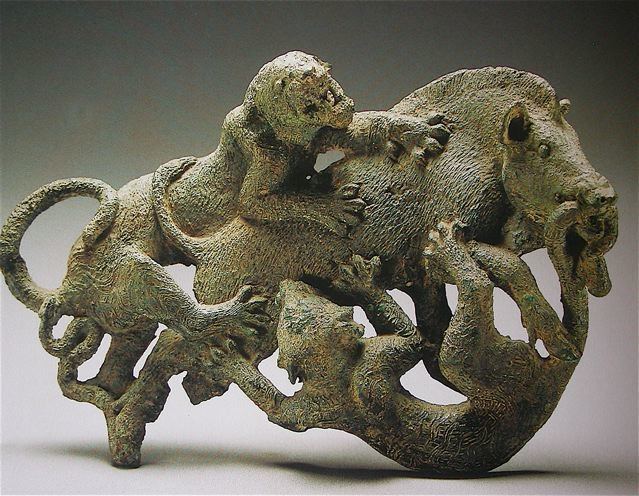Capital Not specified Established 4th century BCE | Government Monarchy Date dissolved 109 BC | |
 | ||
Dutch tug dian kingdom towing wind pioneer from harwich 28 2 17
The Dian Kingdom (simplified Chinese: 滇王国; traditional Chinese: 滇國) was established by the Dian people, who lived around the Dian Lake plateau of central northern Yunnan, China from the late Spring and Autumn period until the Eastern Han dynasty. The Dian buried their dead in vertical pit graves. The Dian language was likely one of the Tibeto-Burman languages. Dian was annexed by the Han dynasty during the southward expansion of the Han dynasty. In 109 BCE, Han campaigns against Dian led to the establishment of the Yizhou commandery by the Han.
Contents
- Dutch tug dian kingdom towing wind pioneer from harwich 28 2 17
- Dutch tug dian kingdom leaving great yarmouth 29 6 16
- History
- Royal burials
- Bronze working
- Scythian influences
- Depiction of Dian society
- Underwater ruins
- Other artifacts
- References

Dutch tug dian kingdom leaving great yarmouth 29 6 16
History

The Dian were first mentioned historically in Sima Qian's Records of the Grand Historian; according to Chinese sources, General Zhuang Qiao of Chu was the founder of the Dian Kingdom. Sent to conquer the "barbarian peoples" of the area, he and his army were prevented from going back to Chu by enemy armies, so he settled down and became king of the new Dian Kingdom. The soldiers who accompanied him married natives.

The kingdom was located around Kunming; it was surrounded on its east by the Yelang tribes, to the west by Kunming tribes, and to the north in Chengdu by the Han Chinese, and had relations with all of them.

It is said that during the reign of King Qingxiang of Chu (298-236 BCE), a military force was sent on a mission to the lands of the Ba and Shu (modern Sichuan), Qinzong (Guizhou), and the Dian Kingdom (Kunming, Yunnan). Native women married the Chu soldiers, who stayed in the area.

The Dian were subjugated by the Han under the reign of Emperor Wu of Han in 109 BCE. The Dian King willingly received the Chinese invasion in the hopes of assistance against rival tribes. It was at this time he received his seal from the Chinese, and became a tributary.
Han campaigns against Dian lead to its territory being incorporated into Yizhou Commandery (Chinese: 益州, modern Sichuan) but left the king of Dian as local ruler until a rebellion during the rule of Emperor Zhao of Han. The Han proceeded with colonization and conquered the people of Kunming in 86 and 82 BCE, reaching Burma.
Royal burials
The Dian buried their kings at Shizhaishan, which was uncovered in 1954 near Shizhai Village in Jinning County, Yunnan. The burials were identified by the inscription King Dian's Seal. The inscription was written in seal script on a gold imperial seal of investiture given by the Han Emperor. Sima Qian noted that the Dian were one of only two local groups to have received an imperial seal, the other being Yelang. Both have survived: the Yelang seal emerged in 2007 from a Hmong man in Guizhou, claiming to be the Yelang king's 75th generation descendant.
Bronze working
The Dian people were sophisticated metal workers, casting both bronze and iron. The Dian cast bronze objects using both the piece mould method and the lost wax method. Dian elite burials contained an impressive array of bronze objects, although late Dian burials also contained locally cast iron objects.
Large bronze drums were employed by the Dian to communicate in battle; ritual burials of Dian elites were accompanied by large bronze drums filled with cowrie shells. The tops of the drums were removed and replaced by a bronze lid.
Scythian influences?
Iaroslav Lebedynsky and Victor H. Mair speculate that some Scythians may also have migrated to the area of Yunnan in southern China following their expulsion by the Yuezhi in the 2nd century BCE. Excavations of the prehistoric art of the Dian civilization of Yunnan have revealed hunting scenes of Caucasoid horsemen in Central Asian clothing. The scenes depicted on these drums sometimes represent these horsemen practicing hunting. Animal scenes of felines attacking oxen are also at times reminiscent of Scythian art both in theme and in composition.
Depiction of Dian society
The bronze lids were covered with miniature figurines and structures, depicting various scenes from the life of the Dian people. The bronze lids depicted the Dian people engaged in everyday activities such as hunting, farming and weaving. Other scenes depicted the leisurely pursuits of the Dian people, such as bullfighting, dancing and music-making. The Dian people dressed in tunics over short pants and wore their hair in topknots. The bronze lids corroborated Sima Qian's description of the Dian hairstyle.
Many scenes depicted the Dian at war, often riding horses. Archaeological evidence shows that horses had been domesticated by the Dian people as early as the sixth century BCE. The bronze lids also depicted the Dian decapitating their enemies (who wore their hair in long plaits).
The Kingdom was based on agriculture, the bronzes also showed head hunting, human sacrifice, and slaves as part of Dian society.
Underwater ruins
Archaeologists recently discovered the inundated remains of Dian-period buildings and pottery fragments under Fuxian Lake and were able to verify their age with carbon dating.
Other artifacts
At Dabona, a site connected with the Dian culture, archaeologists discovered a large double coffin burial; The outer coffin was made of wood and the inner coffin was made of bronze. The inner coffin was shaped like a house and weighs over 157 kg.
The Yunnan Provincial Museum holds many archaeological relics of the Dian culture.
